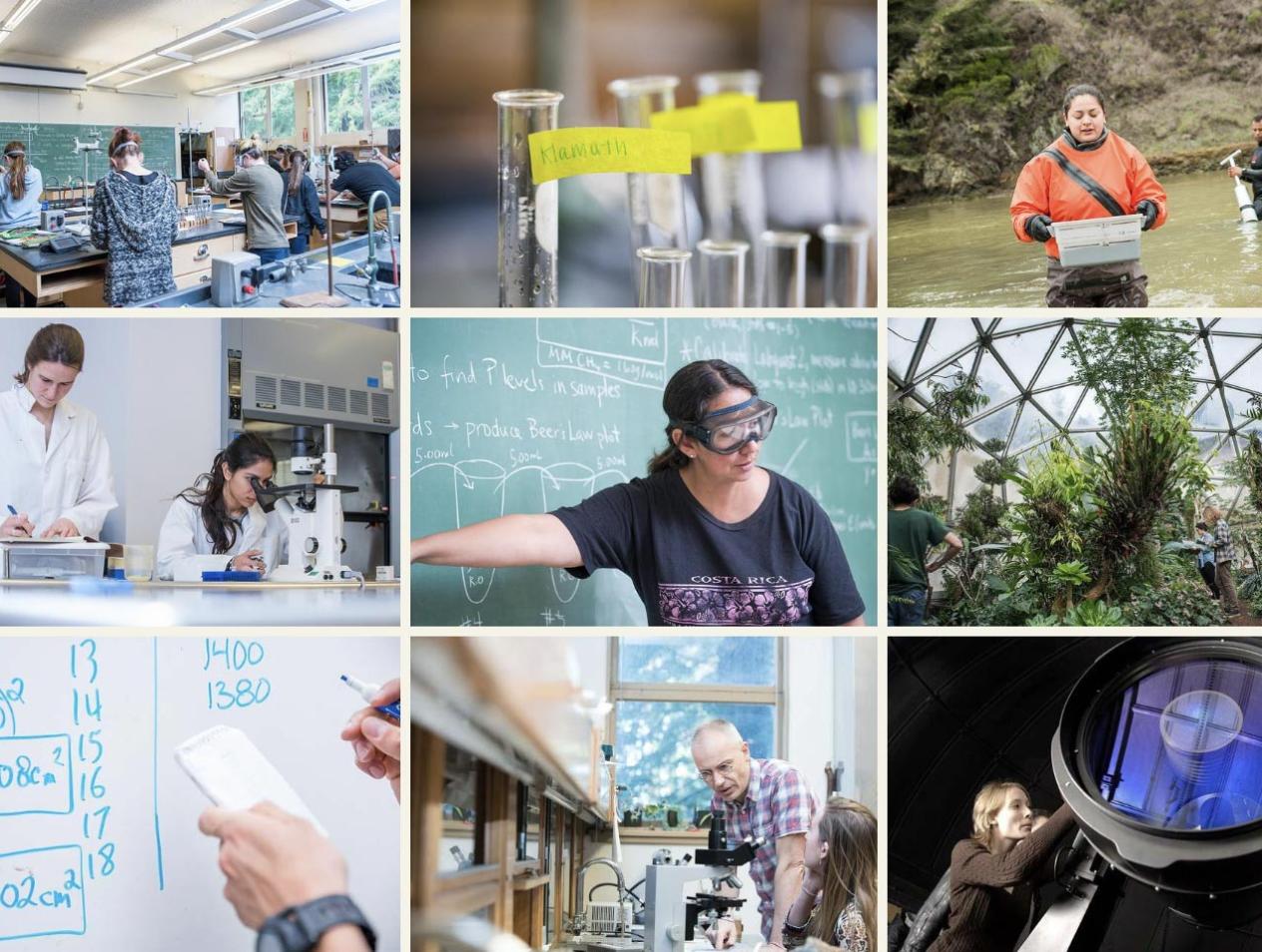Breadcrumb
Achievements
Find out what our students, faculty, and staff are being recognized for.
Tara S. Caso, Robert W. Zoellner
Chemistry
Professor Emeritus Robert W. Zoellner and his former student, Tara S. Caso, have published a peer-reviewed article entitled "The effect of substituents on the hypothetical decomposition energies of triacetone triperoxide (TATP) derivatives: Structures and properties from density functional calculations": T. S Caso, R. W. Zoellner, Journal of Undergraduate Chemistry Research 2022, 21, 106-110.
Alison O'Dowd
Environmental Science & Management
Dr. Alison O'Dowd, with collaborators in the Yurok Tribe and Hoopa Valley Tribe, was awarded $123,000 by the Trinity River Restoration Program to explore the effects of scour and marginal inundation on Trinity River invertebrate communities. River invertebrates are an important food resource for salmonids and this study will investigate if longer periods of winter inundation can bolster invertebrate populations. The other aspect of the study will use monthly invertebrate sampling to see if high-flow winter scouring events can 're-set' the system and increase fish food later in the season (as has been shown in other research).
Pedro Peloso and Brandice Guerra
Biological Sciences
Dr. Pedro Peloso and Brandice Guerra, M.F.A., received a $10,000 grant from the Maxwell/Hanrahan Foundation to support a scientific illustration residency program at Cal Poly Humboldt. The program will recruit a student or recent graduate from anywhere in the world to work with faculty from the departments of Art+Film and Biology. The intern will create a series of illustrations of recently extinct Brazilian frogs, and share their work and artistic process through a lecture or exhibition on campus.
Molly Parren, Daniel Barton, and Barbara Clucas
Wildlife
Molly Parren, MS graduate in Wildlife, published results from her MS thesis research, "Drought and coyotes mediate mesopredator response to human disturbance" in the ESA open-access journal Ecosphere, co-authored with Cal Poly Humboldt faculty Drs. Daniel Barton and Barbara Clucas and CDFW scientists Dr. Brett Furnas and Misty Nelson. This work addressed how California's extreme drought and coyotes in 2013-16 influenced interactions between bobcats, kit foxes, raccoons, and human disturbance at 585 study sites throught California's Central Valley and Mojave Deserts.
Alan Tepley
Forestry, Fire & Rangeland Management
Alan Tepley was the lead author on a paper that evaluates trends in wildfire evacuations across Canada's forested regions over the last four decades. The study summarizes spatial variation in the characteristics of the fires that led to evacuations (e.g., the size, seasonality, and ignition sources) and the communities exposed (e.g., population, access to the road network, and trends in evacuations on First Nations reserves vs. non-reserves). Understanding the key risk factors and how they vary spatially across Canada and temporally over the fire season will aid in planning for future fire seasons.
Hunter Harrill, Will Goldenberg
Forestry, Fire & Rangeland Management
Dr. Hunter Harrill (Forestry, Fire, and Rangeland Management) was invited to deliver a presentation titled, "Creating Immersive Field Trips and Assignments During COVID" for a panel session on Forest Operations Education at the COFE-FORMEC-IUFRO Division 3 International Conference of Forest Engineering, in Corvallis, Oregon, October 4-7th, 2022. His presentation featured the high quality virtual field trips that were filmed and produced by Humboldt alumni Will Goldenberg, that are now helping professors from other universities around the world, to educate their students. Dr. Harrill also served as a moderator for a panel session on Forest Operations Planning Issues and Opportunities.
Dennis Lindelof, Lisa Elconin, Huntington Paulson, Amanda Admire
Geology
On Saturday October 1st, the Geology Club officers, Dennis Lindelof, Lisa Elconin and Huntington Paulson, joined the Redwood Coast Tsunami Work Group and Humboldt Earthquake Education Center to participate in Pastels on the Plaza. Their design promoted the Great ShakeOut happening on October 20th at 10:20 am, and it highlighted the importance of earthquake and tsunami awareness and preparedness. Check out their design on the Arcata Plaza! We encourage everyone to sign up and participate in ShakeOut during Safety Week so you too can practice your earthquake and tsunami drill. Preparedness makes a difference!
Karolyn Fagundes, Hunter Harrill, Susan Marshall, Andrew Stubblefield, Han-Sup Han
Forestry, Fire & Rangeland Management
Karolyn Fagundes (Forestry, Fire, and Rangeland Management) was invited to deliver a presentation highlighting her Master's thesis research, titled, "Assessing Soil Disturbance from a Tethered Feller Buncher on Steep Slopes in Northern California." The presentation was part of a panel session on Environmental Impacts at the COFE-FORMEC-IUFRO Division 3 International Conference of Forest Engineering, in Corvallis, Oregon, October 4-7th, 2022.
Logan Hysen
Wildlife
Logan Hysen, M.S. student from the Department of Wildlife, was selected to be the recipient of a $1,000 scholarship given by the San Francisco Bay Area Chapter of the California Association of Environmental Professionals. The scholarship supports students pursuing a career in the environmental field. Logan is conducting research on environmental impacts on northern spotted owl for his thesis.
Hunter Harrill
Forestry, Fire & Rangeland Management
Dr. Hunter Harrill received a $100,000 grant from the U.S. Forest Service to conduct a study that will determine the size, scale, and capabilities of the logging industry in California. The main objective of the project is to survey the industry to quantify the number of crews that exist and their characteristics (e.g. capacity, employment, equipment, capabilities), and improve our understanding of their challenges, opinions, business outlook, and vision for the future. Findings will inform land managers about the potential for types of forest operations and available capacity in their respective area.






